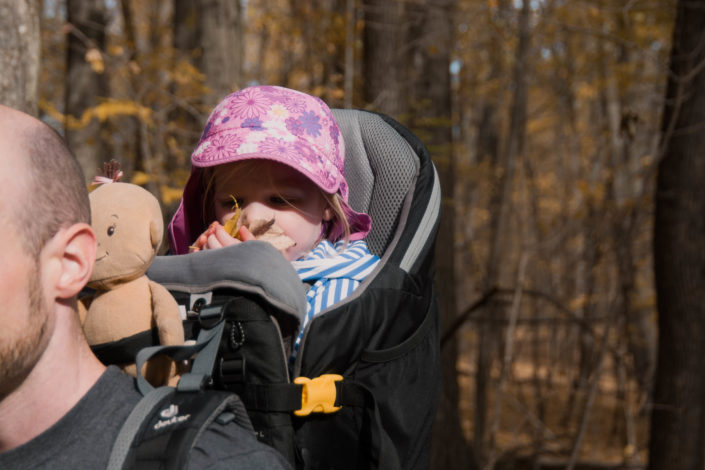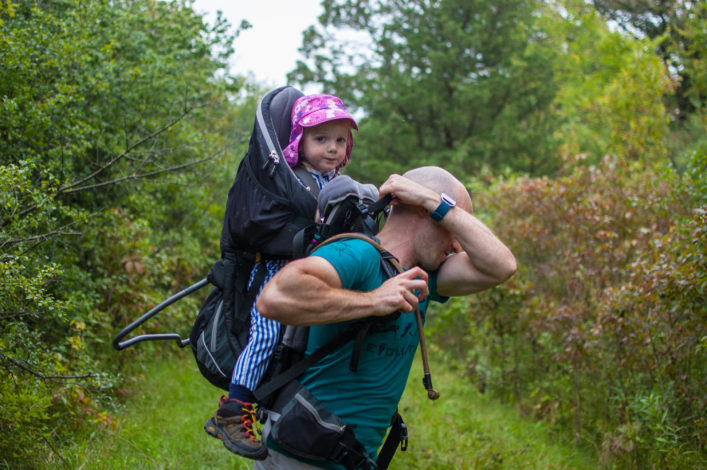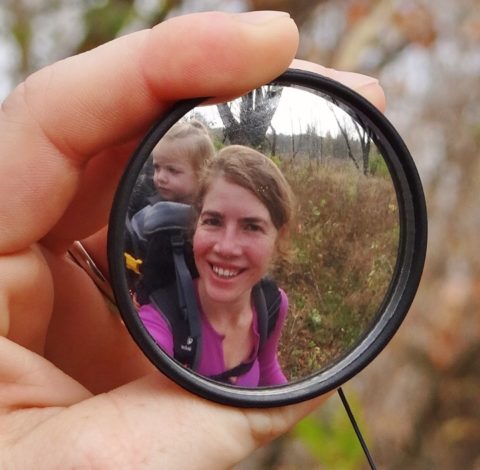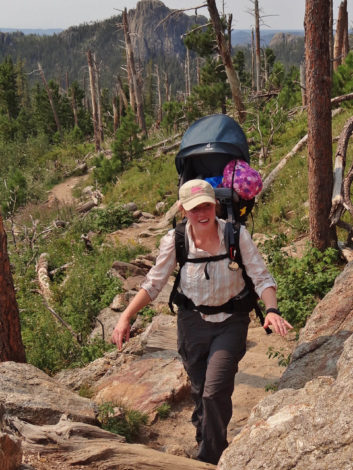Hard-framed carrier: improve the quality of your hike
Sky was a little over a year old when I was finally mentally prepared enough to try a long day hike. I felt confident in what I would need for a full day's hike: 15 diapers, first aid kit, water for a family of eight, food for three days, three outfit changes and rain gear. With everything I needed, I was concerned about having to carry everything I would need with me, a one-year-old and my overactive imagination. Sky was starting to get heavy and I was concerned about footing, so I wanted her on my back, but my buckle-style carriers weren’t prepared to stuff everything. I wasn’t sure I really wanted to carry Sky on my back and a backpack on front (sounded super awkward). Enter the hard-framed carrier.
 Hard-framed carriers (like my beloved Deuter Kid Comfort III) are typically designed to carry both gear and kids. Some don’t have gear compartments ... just skip those. A hard-framed carrier is different from your typical soft-framed carrier or buckle-style carrier. They have an internal frame so your little one sits higher behind you for a great view. Hard-framed carriers are designed to sit differently on your body above your hips, similar to a framed backpack and unlike the typical soft-framed carrier or buckle-style, which can sit anywhere from natural waist to hip.
Hard-framed carriers (like my beloved Deuter Kid Comfort III) are typically designed to carry both gear and kids. Some don’t have gear compartments ... just skip those. A hard-framed carrier is different from your typical soft-framed carrier or buckle-style carrier. They have an internal frame so your little one sits higher behind you for a great view. Hard-framed carriers are designed to sit differently on your body above your hips, similar to a framed backpack and unlike the typical soft-framed carrier or buckle-style, which can sit anywhere from natural waist to hip.



 Hard-framed carriers (like my beloved Deuter Kid Comfort III) are typically designed to carry both gear and kids. Some don’t have gear compartments ... just skip those. A hard-framed carrier is different from your typical soft-framed carrier or buckle-style carrier. They have an internal frame so your little one sits higher behind you for a great view. Hard-framed carriers are designed to sit differently on your body above your hips, similar to a framed backpack and unlike the typical soft-framed carrier or buckle-style, which can sit anywhere from natural waist to hip.
Hard-framed carriers (like my beloved Deuter Kid Comfort III) are typically designed to carry both gear and kids. Some don’t have gear compartments ... just skip those. A hard-framed carrier is different from your typical soft-framed carrier or buckle-style carrier. They have an internal frame so your little one sits higher behind you for a great view. Hard-framed carriers are designed to sit differently on your body above your hips, similar to a framed backpack and unlike the typical soft-framed carrier or buckle-style, which can sit anywhere from natural waist to hip.
A proper fit is important for comfort
Torso Length – Adjust your carrier so that the hip belt will sit on your hips and the weighted carrier’s shoulder straps won’t have a gap on your shoulders. Take the time before you head out on the trail to get this perfect for you. I grabbed a sack of potatoes and tossed it into the seat to get a great fit. I had my partner help me get the perfect fit by some trial and error on adjusting by using their Varifit system. Since it’s an easy strap to adjust, we also marked my partner’s best fit so we could go between the two of us easily. Waistbelt – Put it on your hips. It belongs there. Don’t think of this carrier like your typical Tula or Ergobaby carrier. It’s designed like a backpack and you have to think of adjusting it like that. Shoulder straps – Is there a gap? Is the bottom of the strap under your armpit? Tighten as needed to get your fit. It’s easier to loosen to get the pack on and off as well. Load Adjustment Straps – Those straps going from your shoulder to the pack? Those are the load adjustment straps and perfect for adjusting the pack either closer to you or farther away. Try playing with these as well to see what you like.
Comfort for your kiddo
The hard-framed carriers are also designed with adjustments to help your little one feel comfortable as well. Seat – Look for the seat adjuster to get the right height. You want your child’s head to be above the front of the cockpit with their shoulders below the back rest. If you have a Kid Comfort III like me, I have my daughter periodically rest her head on the pillow so I can make sure she is comfortable when napping. Feet – Look for the stirrups and adjust these so your child’s knees are slightly bent. Harness – Make sure that the harness is snug against your child so they can’t wiggle out (I’ve learned this lesson for you.). Harnesses typically have several points to tighten so you can adjust to the child in that moment. The Deuter Kid Comfort III allows me to move the shoulder straps up and down, so Sky has a perfect fit. You want to make sure the harness is snug as this is what keeps your child in the cockpit. Accessories – If your carrier doesn’t come with it automatically, consider picking up a sunshade. I also highly recommend grabbing the rain protector as it’s very helpful for rain, snow and wind. You may also want to pick up a mirror like this one. It attaches to your carrier and will allow you to view your child.
Extra tips for using a hard-framed carrier
Your baby needs to sit independently. These carriers aren’t designed for kids who can’t sit independently, so don’t use it for newborns or any child who isn’t sitting independently. Each child hits this milestone in their own time. Mind the weight. Each framed carrier has a max weight it can safely carry to include the child, gear, water and the carrier. Sky is a little thing so we have been able to use this carrier for a long time. Each time I consider how much everything weighs (water is heavier than you think). If you are thinking about doing longer hikes and want to take gear along, a hard-framed carrier might be your perfect fit. For me and Sky, it’s allowed us to hike to the top of Black Elk Peak, backpack the Ice Age Trail, keep us on the trails longer and let me do more adult-paced hikes.
Read more:
Photos by Jessica Featherstone. Do you have a fit tip for a hard-framed carrier? Let us know below!Related Content




Comments